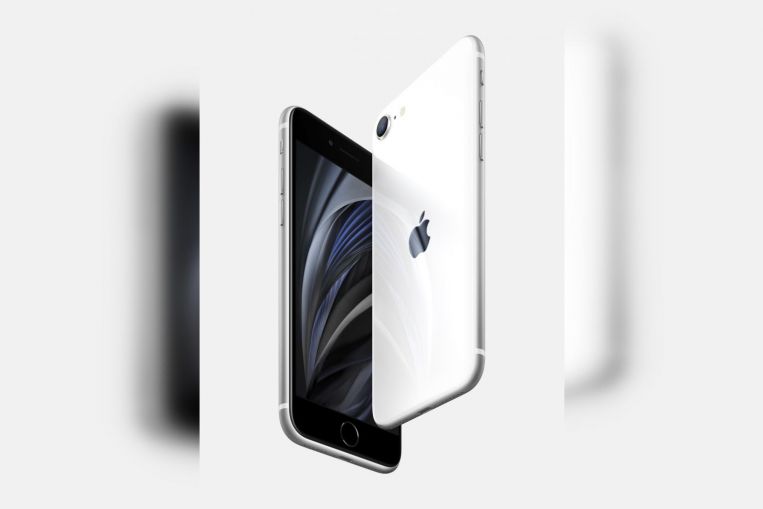The second iteration of Apple’s iPhone SE is practically a dead ringer for the iPhone 8, starting with its front and back that are made of glass (thus allowing it to support wireless charging), and its sides and chassis made of aluminium.
There are also the rounded edges, lack of a headphone jack (which the original iPhone SE has) and the 4.7-inch TrueTone display, which changes colour temperature according to the ambient lighting.
The screen has thick bezels at the top and bottom to house the microphone/front-facing camera and Touch ID button respectively.
The only cosmetic difference between the two phones is that the Apple logo on the new iPhone SE’s back is centred like the flagship iPhone 11 series. Indeed, even iPhone 8 (and iPhone 7) cases will fit this phone.
It is inside the phone where you find a significant difference. The new iPhone SE has the same A13 Bionic chip of the iPhone 11 series. This is why I think of this phone as an “iPhone 9” (the model number Apple skipped after the iPhone 8), as it is basically an iPhone 8 with the same rear and front-facing cameras but upgraded with the latest Apple processor.
Like the iPhone 8, its compactness makes it great for one-handed use. But if you have been using the iPhone X, you will have to get reacquainted to old gestures such as swiping up from the bottom of the display to bring up the command centre.
The Touch ID makes a welcomed return, since we have to wear masks all the time when we are outside these days. With the iPhone X, users have to press the passcode each time they want to unlock the phone because its Face ID feature cannot recognise a masked face. For essential workers who need to wear a mask all the time, Touch ID would be even more appreciated.
The new iPhone SE nearly matches its flagship cousins in processing speed. In the Geekbench 5 benchmark test, it scored 1,331 (single-core) and 3,072 (multi-core). The iPhone 11 scored 1,328 (single-core) and 3,384 (multi-core).
But its performance in this test is better than Samsung’s latest flagship Galaxy S20 Ultra, which scored 917 (single-core) and 2,769 (multi-core). Playing games such as racing game Asphalt 9 and shooter PlayerUnknown Battlegrounds Mobile feels smooth without any lag.
Given its entry-level status, I was not expecting its camera performance to be as good as that of its flagship cousins, given that it lacks the rear dual- or triple-camera system or the TrueDepth front-facing camera of the latter.
It also does not have Night mode and Deep Fusion technology that takes multiple shots and combines them for the best one. But it still has Portrait mode and Smart high dynamic range (HDR).
Comparing photos taken with my iPhone 11 Pro Max and the new iPhone SE, I found the HDR effect in landscape shots pretty similar, but the dark areas of the photos taken by the new iPhone SE are more grainy.
In addition, the bokeh effect on Portrait mode is not as natural as that of the iPhone 11 Pro Max. Plus, Portrait mode will not work unless it detects a person.
You can still take selfies in Portrait mode, though they pack less details than selfies from the iPhone 11 Pro Max. But overall, the camera performance is still good for its price.
In our video loop test, the new iPhone SE lasted 6 hours 30 minutes compared to iPhone 11’s 11 hours and 20 minutes.Under normal use, it should last a working day. But if you are making deliveries and thus using the phone a lot, a power bank might be needed.
Perhaps, the best feature of the new iPhone SE is its price. While its price range of $649 to $889 might seem pricey, it might cost nothing if you sign a telco contract.
With the latest processor, Wi-Fi 6 support and given Apple’s software support for old iPhones go for as long as five years, the new iPhone SE is not only the most affordable iPhone now, it could save you money in the long run since it should be good enough to ward off the upgrade urge for a while.
And in these trying times, this is just the smartphone that users of older iPhones can upgrade to.
FOR
– Most affordable iPhone now
– Superb performance for its price
– Top-notch one-hand handling
– iPhone 8 case can be reused on it
– Good camera performance
AGAINST
– Same design as iPhone 8
– Battery life could be better
– Rear camera lacks Night mode
TECH SPECS
Price: $649 (64GB), $719 (128GB), $889 (256GB, version tested)
Processor: A13 Bionic six-core chip with embedded neural engine
Screen: 4.7-inch LCD (1,334 x 750 pixels), 326 pixels per inch
Operating system: iOS 13.4
Rear camera: 12-megapixel wide-angle f/1.8
Front camera: 7-megapixel f/2.2
Memory: 256GB, 3GB RAM
Battery: 1,821mAh
Weight: 148g
RATING
Features: 4/5
Design: 3.5/5
Performance: 4/5
Battery life: 3.5/5
Value for money: 4/5
Overall: 4/5
This article contains affiliate links. If you buy through these links, we may earn a small commission.
Source: Read Full Article
